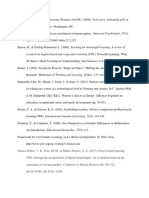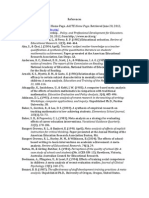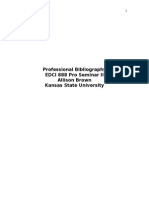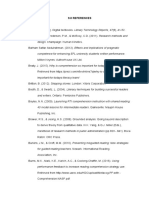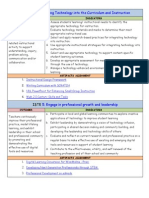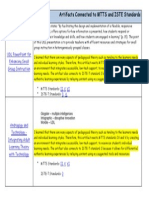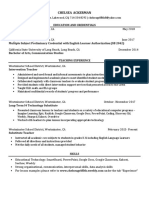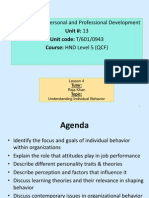Reference Page
Reference Page
Uploaded by
Joshua CoxCopyright:
Available Formats
Reference Page
Reference Page
Uploaded by
Joshua CoxCopyright
Available Formats
Share this document
Did you find this document useful?
Is this content inappropriate?
Copyright:
Available Formats
Reference Page
Reference Page
Uploaded by
Joshua CoxCopyright:
Available Formats
Reference Page ISTC 675: Hicks, S. (2011). Technology in today's classroom: Are you a tech-savvy teacher?
Clearing House, 84(5), 188191. Retrieved from doi:10.1080/00098655.2011.557406. Kadijevich, Dj. (2006). Achieving educational technology standards: the relationship between student teachers interest and institutional support offered. Journal of Computer Assisted Learning, 22(6), 437-443. Retrieved from EBSCOhost. Kovalik, C., Smolen, L., and Toddy, J. (2001). Technology standards in a third-grade classroom. Journal of Research on Computing in Education, 33(5), 1-17. Retrieved from EBSCOhost. Papert, S. (1993). The children's machine. New York: Basic Books. Prensky, M. (2001a, September/October). Digital natives, digital immigrants. On the Horizon, 9(5), 1-6. Prensky, M. (2001b, November/December). Digital natives, digital immigrants, part 2: Do they really think differently? On the Horizon, 9(6), 1-6. Adodo S. O., & Agbayewa J. O. (2011). Effect of homogenous and heterogeneous ability grouping class teaching on students interest, attitude and achievement in integrated science. International Journal of Psychology and Counselling, ol. 3(3), 48-54. Retrieved from Academic Search Premier.
Banfield, T. (2005). Ability grouping for mathematically gifted adolescent boys. International Education Journal, 6(2), 141-149. Retrieved from Academic Search Premier.
Huang, M. (2009). Classroom homogeneity and the distribution of student math performance: A country-level fixed-effects analysis. Social Science Research, 38(4), 781-791. doi:DOI: 10.1016/j.ssresearch.2009.05.001
Ireson, J., & Hallam, S. (2009). Academic self-concepts in adolescence: Relations with achievement and ability grouping in schools. Learning and Instruction, 19(3), 201-213. doi:DOI: 10.1016/j.learninstruc.2008.04.001
Lleras, C., & Rangel, C. (2009). Ability grouping practices in elementary school and african American/Hispanic achievement. American Journal of Education, 115(2), 279-304. Retrieved from Academic Search Premier.
McCoach, D. B., O'Connell, A. A., & Levitt, H. (2006). Ability grouping across kindergarten using an early childhood longitudinal study. Journal of Educational Research, 99(6), 339-346. Retrieved from Academic Search Premier.
Saleh, M., Lazonder, A. W., & Jong, T. d. (2007). Structuring collaboration in mixed-ability groups to promote verbal interaction, learning, and motivation of average-ability students. Contemporary Educational Psychology, 32(3), 314-331. doi:DOI: 10.1016/j.cedpsych.2006.05.001
Schweiker-Marra, K., & Pula, J. J. (2005). Effects of a homogeneous low-tracked program on academic performance of at-risk students. Delta Kappa Gamma Bulletin, 71(2), 34-58.
Slavin, R. (1987). Ability grouping and student achievement in elementary schools: A best-evidence synthesis. Review of Educational Research, 57(3), 293-336. doi:10.2307/1170460
Kim, L., & Zitzer, M. (1999). Powerful Learning Framework for Teachers. Retrieved by ERIC Database. Driscoll, M. P. (1994). Psychology of learning for instruction. Boston: Allyn and Bacon.
Duffy T. M. & Jonassen, D. (Eds.). (1992). Constructivism and the technology of instruction: A conversation. Mahwah, NJ: Lawrence Erlbaum Associates, Inc. Regan, M. & Sheppard, S. (1996). Interactive multimedia courseware and the hand-on learning experience: An assessment study. Journal of Engineering Education, April 1996, 123-131. Stoof, A., Martens, R.L., & Van Merrienboer, J. (2006). Effects of web-based support for the construction of competence maps. Instructional Science, 34, 189-211.
Brown, A., & Green, T. G. (2010). The essentials of instructional design: Connecting fundamental principles with process and practice (2nd Ed.). Upper Saddle River, NJ: Merrill 2 Prentice Hall.
Ertmer, P., & Quinn, J. (2007). The ID casebook: Case studies in instructional design, 3rd ed. Upper Saddle River, NJ: Merrill Prentice Hall.
Driscoll, M.P. (2005). Psychology of Learning for Instruction. (3rd Ed.). Boston: Allyn and Bacon. (ISBN: 0205375197)
Becker, H. J., & Ravitz, J. L. (2001). Computer use by teachers: Are Cuban's predictions correct? Paper presented at the 2001 Annual Meeting of the American Educational Research Association, Seattle, Washington. Retrieved July 2007 from http://www.crito.uci.edu/tlc/findings/conferences-pdf/aera_2001.pdf CEO Forum on Education and Technology (2001, June). The CEO Forum school technology and readiness report: Key building blocks for student achievement in the 21st century. Retrieved July, 2007 from http://www.ceoforum.org/downloads/report4.pdf. International Society for Technology in Education (2000-2007). National Educational Technology Standards. Retrieved August, 2007 from http://cnets.iste.org/ncate/n_lead-stands.html National School Boards Foundation (2003). Educational Leadership Toolkit. Retrieved August, 2007 from http://www.nsba.org/sbot/toolkit/ November, A. (2007). Archive of Articles. Retrieved July, 2007 from www.anovember.com/Default.aspx?tabid=132. United States Department of Education (2006). National educational technology plan. Retrieved August 2007 from http://www.ed.gov/about/offices/list/os/technology/plan/2004/site/edlite-default.html Valdez, G. (2004, July). Technology leadership: Enhancing positive educational change. North Central Regional Educational Laboratory. Retrieved July, 2007 from http://www.ncrel.org/sdrs/areas/issues/educatrs/leadrshp/le700.htm. Schrum, L. & Levin, B. (2009). Leading 21 century schools: Harnessing technology for engagement and achievement. Thousand Oaks, CA: Corwin Press. (required) Brooks-Young, S. (2009). Making technology standards work for you: A guide to the NETS-A for administrators with selfassessment activities. Eugene, OR: ISTE. (recommended)
st
Required Texts: Christensen, C. M., Horn, M. B., & Johnson, C. W. (2008). Disrupting class: how disruptive innovation will change the way the world learns. New York: McGraw-Hill. Edwards, M. (2013). Every child, every day: a digital conversion model for student achievement . Boston: Pearson. Fullan, M. (2013). Stratosphere. Ontario: Pearson. Additional Resources: Bennis, W., Spreitzer, G. M., & Cummings, T. G. (2010). The future of leadership: today's top leadership thinkers speak to tomorrow's leaders.. S.l.: Jossey-Bass. Blueprint 2.0: Strategic Framework. (2013, January 1). Baltimore County Public Schools. Retrieved April 21, 2013, from https://www.bcps.org/system/ Christensen, C. M., Horn, M. B., & Staker, H. (2013, May 1). Is K12 blended learning disruptive?An introduction of the theory of hybrids | Christensen Institute. Clayton Christensen Institute for Disruptive Innovation. Retrieved May 19, 2013, from http://www.christenseninstitute.org/publications/hybrids/
Fullan, M. (2007). The new meaning of educational change (4th ed.). New York: Teachers College Press. Fullen, M., Cutress, C., & Kilcher, A. (2005). 8 Forces for Leaders of Change . JSD, 26 , , rom .michael ullan.com media .pd , . etrieved arch
Hargreaves, A., Earl, l., Moore, S., & Manning, S. (2001). Learning to change: teaching beyond subjects and standards. San Francisco: Jossey-Bass. Kay, K., & Lentz, B. (2013, March 26). Which Path for the Common Core?. EdWeek. Retrieved April 12, 2013, from www.edweek.org/ew/articles/2013/03/22/26kay.h32.html Rogers, E. M. (2003). Diffusion of innovations (5th ed.). New York: Free Press. Strategic Plan for Fiscal Years 2007-12. (2012, April 1). ED Strategic Plans and Annual Reports. U.S. Department of Education. Retrieved May 29, 2013, from http://www2.ed.gov/about/reports/strat/index.html West, D. M., & Bleiberg, J. (2013). Education Technology Success Stories. Technology Innovation at Brookings, 1(March), 1-19. Retrieved April 13, 1920, from http://www.brookings.edu/research/papers/2013/03/20education-technology-success-west-bleiberg Adodo S. O., & Agbayewa J. O. (2011). Effect of homogenous and heterogeneous ability grouping class teaching on students interest, attitude and achievement in integrated science. International Journal of Psychology and Counselling, ol. 3(3), 48-54. Retrieved from Academic Search Premier.
Banfield, T. (2005). Ability grouping for mathematically gifted adolescent boys. International Education Journal, 6(2), 141-149. Retrieved from Academic Search Premier.
Huang, M. (2009). Classroom homogeneity and the distribution of student math performance: A country-level fixed-effects analysis. Social Science Research, 38(4), 781-791. doi:DOI: 10.1016/j.ssresearch.2009.05.001
Ireson, J., & Hallam, S. (2009). Academic self-concepts in adolescence: Relations with achievement and ability grouping in schools. Learning and Instruction, 19(3), 201-213. doi:DOI: 10.1016/j.learninstruc.2008.04.001
Lleras, C., & Rangel, C. (2009). Ability grouping practices in elementary school and african American/Hispanic achievement. American Journal of Education, 115(2), 279-304. Retrieved from Academic Search Premier.
McCoach, D. B., O'Connell, A. A., & Levitt, H. (2006). Ability grouping across kindergarten using an early childhood longitudinal study. Journal of Educational Research, 99(6), 339-346. Retrieved from Academic Search Premier.
Saleh, M., Lazonder, A. W., & Jong, T. d. (2007). Structuring collaboration in mixed-ability groups to promote verbal interaction, learning, and motivation of average-ability students. Contemporary Educational Psychology, 32(3), 314-331. doi:DOI: 10.1016/j.cedpsych.2006.05.001
Schweiker-Marra, K., & Pula, J. J. (2005). Effects of a homogeneous low-tracked program on academic performance of at-risk students. Delta Kappa Gamma Bulletin, 71(2), 34-58.
Slavin, R. (1987). Ability grouping and student achievement in elementary schools: A best-evidence synthesis. Review of Educational Research, 57(3), 293-336. doi:10.2307/1170460
Basham, James D., Israel, Maya, Graden, Janet, Poth, Rita, & Winston, Markay. (2010). A comprehensive approach to RTI: Embedding Universal Design for Learning and technology. Learning Disabled Quarterly, 33(4). 243-255. Retrieved from Academic Search Premier (EBSCO) database. Edyburn, Dave L. (2010). Would you recognize Universal Design for Learning if you saw it? Ten propositions for new directions for the second decade of UDL. Learning Disabled Quarterly, 33(1). 33-41. Retrieved from Academic Search Premier (EBSCO) database. King-Sears, Margaret. (2009). Universal Design for Learning: Technology and pedagogy. Learning Disabled Quarterly, 32(4). 199-201. Retrieved from Academic Search Premier (EBSCO) database. Ralabate, Patricia K. (2011). Universal Design for Learning: Meeting the needs of all students. ASHA Leader, 16 (10). 14-17. Retrieved from Academic Search Premier (EBSCO) database.
https://strentacoste.wikispaces.com/ http://alyssalindsey.pbworks.com/w/page/76229420/Implementing%20UDL%20at%20Halstead%20Academy https://sites.google.com/site/ryanogrady/leadership/livebinder https://sites.google.com/site/alishamaaloufportfolio/artifact-4
You might also like
- Psych Nursing LectureDocument449 pagesPsych Nursing LectureButch DumdumNo ratings yet
- Bonk, C. J., & Zhang, K. (2009) - Empowering Online Learning: 100+ Activities For ReadingDocument10 pagesBonk, C. J., & Zhang, K. (2009) - Empowering Online Learning: 100+ Activities For Readingapi-289085128No ratings yet
- References PDFDocument7 pagesReferences PDFresigjeflinNo ratings yet
- DAFTAR Daftar Referensi Yang DipakaiDocument17 pagesDAFTAR Daftar Referensi Yang Dipakaidianadiarohmah311No ratings yet
- Daftar PustakaDocument9 pagesDaftar PustakaNiar alhusna niarNo ratings yet
- REFERENCESDocument12 pagesREFERENCESRichelle IldefonsoNo ratings yet
- Motivation Reference ListDocument4 pagesMotivation Reference Listapi-198185569No ratings yet
- 06 BackDocument68 pages06 Backaderina9032No ratings yet
- Literature Cited Curriculum VitaeDocument16 pagesLiterature Cited Curriculum VitaeMaryjane JuguilonNo ratings yet
- AppendicesDocument32 pagesAppendicesivy malanogNo ratings yet
- REFERENCESDocument4 pagesREFERENCESRudy LangiNo ratings yet
- 14 BibliographyDocument11 pages14 Bibliography9415697349No ratings yet
- LR ReferencesDocument3 pagesLR Referencesapi-364417971No ratings yet
- Daftar PustakaDocument6 pagesDaftar PustakaJuli FirmanNo ratings yet
- بحثDocument31 pagesبحثNoura AlshammriNo ratings yet
- referensiDocument9 pagesreferensienengyunianti26No ratings yet
- ReferencesDocument4 pagesReferencesapi-253756492No ratings yet
- Backward Design and Effective Student LearningDocument8 pagesBackward Design and Effective Student Learningapi-148362218No ratings yet
- Relation. 55 (3), 279-291: Daftar PustakaDocument5 pagesRelation. 55 (3), 279-291: Daftar PustakaChika FebrianiNo ratings yet
- Daftar PustakaDocument12 pagesDaftar Pustakamuhammadnugroho.2023No ratings yet
- Profissional Bibliography FinalDocument6 pagesProfissional Bibliography Finalapi-248818533No ratings yet
- Participant Demographics: Chart 1Document19 pagesParticipant Demographics: Chart 1api-497969725No ratings yet
- Action Plan ReferenceDocument4 pagesAction Plan Referencensh6cxtpq7No ratings yet
- Final ReferencesDocument114 pagesFinal ReferencesAce CardenoNo ratings yet
- Andrew J. Saltarelli, PH.D.: Professional CertificatesDocument8 pagesAndrew J. Saltarelli, PH.D.: Professional CertificatesajsaltsNo ratings yet
- Cohort BibDocument8 pagesCohort Bibkingsley4No ratings yet
- References: Intel Teach Elements Inquiry in The Science ClassroomDocument5 pagesReferences: Intel Teach Elements Inquiry in The Science ClassroomjacafyNo ratings yet
- School Form 10 SF10-SHS Senior High School Student Permanent RecordDocument4 pagesSchool Form 10 SF10-SHS Senior High School Student Permanent RecordRolly Dominguez BaloNo ratings yet
- references-3iDocument13 pagesreferences-3iSTEM1 LOPEZNo ratings yet
- ReferencesDocument8 pagesReferencesHa PiNo ratings yet
- Daftar Bacaan Atau Sumber Belajar LainDocument5 pagesDaftar Bacaan Atau Sumber Belajar Lainppg.galuhfebrianggono92No ratings yet
- References For Critical ReflectionsDocument5 pagesReferences For Critical Reflectionsapi-294816434No ratings yet
- Costelo Et Al REFERENCESDocument7 pagesCostelo Et Al REFERENCESAngelGerald CosteloNo ratings yet
- Reference-List RevDocument7 pagesReference-List RevᏗᏖᏋ ᏗᏝᏗᎥᎥNo ratings yet
- Teaching Occasional Papers, 22Document2 pagesTeaching Occasional Papers, 22Michael Cristal TaperlaNo ratings yet
- 12 - AnnexuresDocument43 pages12 - AnnexuresDr. K.MALININo ratings yet
- BIBILIOGRAPHYDocument2 pagesBIBILIOGRAPHYMeily ZoelNo ratings yet
- Spe 503 ReferencesDocument14 pagesSpe 503 ReferencesjmstetekluhNo ratings yet
- BIBLIOGRAFIE FundamentareDocument10 pagesBIBLIOGRAFIE FundamentareCostel-Daniel NeicuNo ratings yet
- Daftar Pustaka NDocument10 pagesDaftar Pustaka NArif Rahmat ZainNo ratings yet
- BibliographyDocument5 pagesBibliographyapi-299295140No ratings yet
- ReferencesDocument7 pagesReferencesDiana MarieNo ratings yet
- ReferencesDocument39 pagesReferencesAndi SyahputraNo ratings yet
- Professional Bibliography EDCI 888 Pro Seminar II Allison Brown Kansas State UniversityDocument6 pagesProfessional Bibliography EDCI 888 Pro Seminar II Allison Brown Kansas State Universityapi-283619550No ratings yet
- Pendidikan Fisika, 5 (6) ,: Daftar PustakaDocument7 pagesPendidikan Fisika, 5 (6) ,: Daftar PustakaHerma SafitriNo ratings yet
- Rodriguez, A. G. & Mckay, S. (2010) - Professional Development For Experienced Teachers Working WithDocument4 pagesRodriguez, A. G. & Mckay, S. (2010) - Professional Development For Experienced Teachers Working WithAaron Jay MondayaNo ratings yet
- BIBLIOGRAPHYDocument6 pagesBIBLIOGRAPHYJay BetaizarNo ratings yet
- Esther Ref..Document10 pagesEsther Ref..Dominion OpemideNo ratings yet
- !references ArDocument8 pages!references ArFelicia OngNo ratings yet
- Daftar PustakaDocument7 pagesDaftar Pustakayustina hasibuanNo ratings yet
- STEM Education in Rural SchoolsDocument2 pagesSTEM Education in Rural SchoolsRichar Manuel Simanca FontalvoNo ratings yet
- SSRN Id3359091Document81 pagesSSRN Id3359091Karen Joy Francisco HabanaNo ratings yet
- Research in Higher Education. 2010. Taylor & Francis JournalsDocument11 pagesResearch in Higher Education. 2010. Taylor & Francis JournalsSandra Pogoy AñascoNo ratings yet
- Teaching With Technology (P. 75-108) - San Francisco: Jossey-Bass. Retrieved FromDocument4 pagesTeaching With Technology (P. 75-108) - San Francisco: Jossey-Bass. Retrieved FromRebecca SkucasNo ratings yet
- Siming Feng ReferencesDocument5 pagesSiming Feng Referencesapi-269225610No ratings yet
- Daftar PustakaDocument9 pagesDaftar Pustakarisma berkatiNo ratings yet
- References FinalDocument2 pagesReferences Finalapi-509187625No ratings yet
- References 18 MarchDocument15 pagesReferences 18 MarchTharishni AnblaganNo ratings yet
- Journal of Science and Research (IJSR), 2 (12), 146-148. Retrieved FromDocument7 pagesJournal of Science and Research (IJSR), 2 (12), 146-148. Retrieved FromBeatrice VelascoNo ratings yet
- Pedagogy & Practice for Online English Language Teacher EducationFrom EverandPedagogy & Practice for Online English Language Teacher EducationNo ratings yet
- Remaking College: The Changing Ecology of Higher EducationFrom EverandRemaking College: The Changing Ecology of Higher EducationNo ratings yet
- CFIPDocument2 pagesCFIPJoshua CoxNo ratings yet
- Professional Development On Using Edmodo: Time CollaborationDocument2 pagesProfessional Development On Using Edmodo: Time CollaborationJoshua CoxNo ratings yet
- Conversation ChecklistDocument1 pageConversation ChecklistJoshua CoxNo ratings yet
- Data Analysis ExplanationDocument2 pagesData Analysis ExplanationJoshua CoxNo ratings yet
- Developing Next Generation Professionals Through STEM: Time CollaborationDocument1 pageDeveloping Next Generation Professionals Through STEM: Time CollaborationJoshua CoxNo ratings yet
- Artifact Connection To StandardsDocument1 pageArtifact Connection To StandardsJoshua CoxNo ratings yet
- Tech Int - Artifacts Connected To MTTS and ISTE StandardsDocument2 pagesTech Int - Artifacts Connected To MTTS and ISTE StandardsJoshua CoxNo ratings yet
- CFIPDocument2 pagesCFIPJoshua CoxNo ratings yet
- Leadership Abilities & Knowledge: Every Child, Every Day: A Digital Conversion Model For Student AchievementDocument1 pageLeadership Abilities & Knowledge: Every Child, Every Day: A Digital Conversion Model For Student AchievementJoshua CoxNo ratings yet
- V. Integrating Technology Into The Curriculum and InstructionDocument1 pageV. Integrating Technology Into The Curriculum and InstructionJoshua CoxNo ratings yet
- Artifacts ConnectionsDocument1 pageArtifacts ConnectionsJoshua CoxNo ratings yet
- Curriculum - SCRATCH Rev1Document2 pagesCurriculum - SCRATCH Rev1Joshua CoxNo ratings yet
- Pedagogical-Artifacts Connected To MTTS and ISTE StandardsDocument1 pagePedagogical-Artifacts Connected To MTTS and ISTE StandardsJoshua CoxNo ratings yet
- Appendix A: Standards Link To Problem in ProgressionDocument6 pagesAppendix A: Standards Link To Problem in ProgressionJoshua CoxNo ratings yet
- Curriculum Explanation Rev1Document2 pagesCurriculum Explanation Rev1Joshua CoxNo ratings yet
- Standard 1Document1 pageStandard 1Joshua CoxNo ratings yet
- Artifacts ConnectionsDocument1 pageArtifacts ConnectionsJoshua CoxNo ratings yet
- Curriculum-Artifacts Connected To MTTS and ISTE Standards - Rev1Document2 pagesCurriculum-Artifacts Connected To MTTS and ISTE Standards - Rev1Joshua CoxNo ratings yet
- Curriculum - ID Framework - Rev1Document2 pagesCurriculum - ID Framework - Rev1Joshua CoxNo ratings yet
- Midterm - Module 1. Understanding Work ImmersionDocument11 pagesMidterm - Module 1. Understanding Work ImmersionNaomi Celestine VeraNo ratings yet
- Central Mindanao University: University Town, Musuan, 8710 BukidnonDocument1 pageCentral Mindanao University: University Town, Musuan, 8710 BukidnonShamarie Love MaribaoNo ratings yet
- Standards Unwrapping Template - 1st GradeDocument3 pagesStandards Unwrapping Template - 1st Gradeapi-531333515No ratings yet
- EDUC20 Lesson PlanDocument2 pagesEDUC20 Lesson PlanKaylee Aromin75% (4)
- Self-Assessment Tool For Teacher I-Iii (Proficient Teachers) For SY 2021-2022Document5 pagesSelf-Assessment Tool For Teacher I-Iii (Proficient Teachers) For SY 2021-2022Suoerman AlmonedaNo ratings yet
- Healing Garden ArchitectureDocument2 pagesHealing Garden Architecturedivyani dalal0% (1)
- Final Resume HB 1Document1 pageFinal Resume HB 1api-329629060No ratings yet
- Session Presentation - The Nature of Reading Without VideoDocument40 pagesSession Presentation - The Nature of Reading Without VideoMary France DuranteNo ratings yet
- Motivation Process: Fousiya T PDocument13 pagesMotivation Process: Fousiya T PFouzia imzNo ratings yet
- CaseDocument2 pagesCaseMalik Aali AhsanNo ratings yet
- Schizophrenia Research: Claire I. Yee Tina Gupta, Vijay A. Mittal, Claudia M. HaaseDocument7 pagesSchizophrenia Research: Claire I. Yee Tina Gupta, Vijay A. Mittal, Claudia M. HaaseKhingZhevenNo ratings yet
- Emotional Freedom Technique & Energy Psychology: Introduction To Eft Youtube Video With Gary CraigDocument3 pagesEmotional Freedom Technique & Energy Psychology: Introduction To Eft Youtube Video With Gary CraigDarko Zhì HuìNo ratings yet
- My Calling..Document1 pageMy Calling..Angelica Mae Angelo BernalNo ratings yet
- Contrasting Styles CaseDocument15 pagesContrasting Styles CaseZaheer Aslam100% (7)
- Teaching PhilosophyDocument2 pagesTeaching Philosophyapi-285458237No ratings yet
- Develop Competency-Based Assessment PlansDocument52 pagesDevelop Competency-Based Assessment Plansthehrscientist100% (2)
- Ch-7 Motivation ConceptsDocument17 pagesCh-7 Motivation ConceptsmasoodNo ratings yet
- An Assignment Submitted byDocument4 pagesAn Assignment Submitted byChristeeba F MNo ratings yet
- Emotional DisturbanceDocument57 pagesEmotional DisturbanceLeancel Homeres100% (1)
- BarsDocument3 pagesBarssogatNo ratings yet
- Lesson Plan JonalynDocument16 pagesLesson Plan JonalynLolicon GamingNo ratings yet
- Sharma, G. and Tolani, B., (2015)Document4 pagesSharma, G. and Tolani, B., (2015)Yeu Jer TayNo ratings yet
- Kursus DLP Pismp Sains Blooms Taxonomy Questions DevisingDocument17 pagesKursus DLP Pismp Sains Blooms Taxonomy Questions Devising胡佳玲No ratings yet
- Lesson 4-Individual BehaviourDocument42 pagesLesson 4-Individual BehaviourSayed MazakatNo ratings yet
- Kayla's Story: Living With Borderline Personality DisorderDocument2 pagesKayla's Story: Living With Borderline Personality DisorderMae Ann BarnidoNo ratings yet
- Códigos Genéticos de VitimismoDocument2 pagesCódigos Genéticos de VitimismoLeandro RochaNo ratings yet
- The Roles of Management To Increase Efficiency For EmployeesDocument7 pagesThe Roles of Management To Increase Efficiency For EmployeesdominickNo ratings yet
- Episode 2Document9 pagesEpisode 2Allan Joneil LataganNo ratings yet
- NYS Dyslexia Awareness Day at The CapitolDocument6 pagesNYS Dyslexia Awareness Day at The CapitolDebra McDade Rafferty100% (1)












